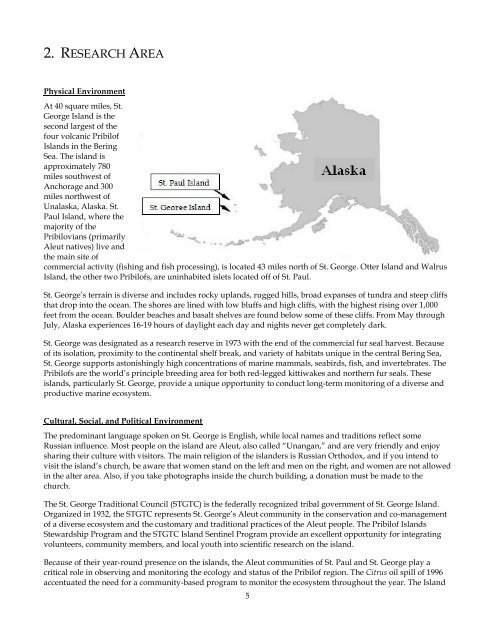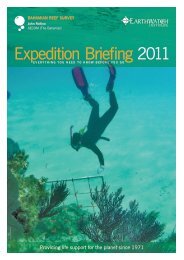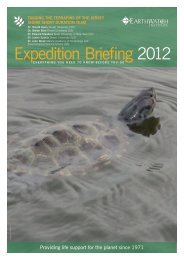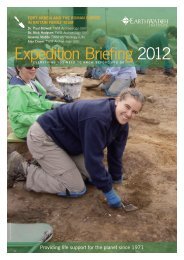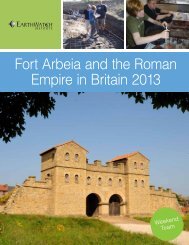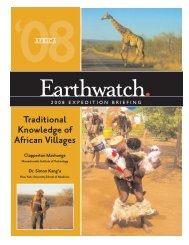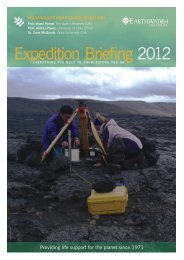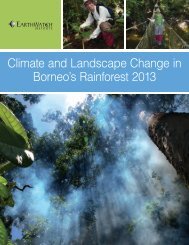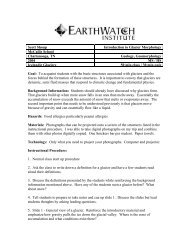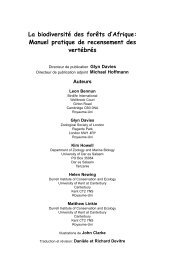Alaskan Fur Seals - Earthwatch Institute
Alaskan Fur Seals - Earthwatch Institute
Alaskan Fur Seals - Earthwatch Institute
Create successful ePaper yourself
Turn your PDF publications into a flip-book with our unique Google optimized e-Paper software.
2. RESEARCH AREA<br />
Physical Environment<br />
At 40 square miles, St.<br />
George Island is the<br />
second largest of the<br />
four volcanic Pribilof<br />
Islands in the Bering<br />
Sea. The island is<br />
approximately 780<br />
miles southwest of<br />
Anchorage and 300<br />
miles northwest of<br />
Unalaska, Alaska. St.<br />
Paul Island, where the<br />
majority of the<br />
Pribilovians (primarily<br />
Aleut natives) live and<br />
the main site of<br />
commercial activity (fishing and fish processing), is located 43 miles north of St. George. Otter Island and Walrus<br />
Island, the other two Pribilofs, are uninhabited islets located off of St. Paul.<br />
St. George’s terrain is diverse and includes rocky uplands, rugged hills, broad expanses of tundra and steep cliffs<br />
that drop into the ocean. The shores are lined with low bluffs and high cliffs, with the highest rising over 1,000<br />
feet from the ocean. Boulder beaches and basalt shelves are found below some of these cliffs. From May through<br />
July, Alaska experiences 16-19 hours of daylight each day and nights never get completely dark.<br />
St. George was designated as a research reserve in 1973 with the end of the commercial fur seal harvest. Because<br />
of its isolation, proximity to the continental shelf break, and variety of habitats unique in the central Bering Sea,<br />
St. George supports astonishingly high concentrations of marine mammals, seabirds, fish, and invertebrates. The<br />
Pribilofs are the world’s principle breeding area for both red-legged kittiwakes and northern fur seals. These<br />
islands, particularly St. George, provide a unique opportunity to conduct long-term monitoring of a diverse and<br />
productive marine ecosystem.<br />
Cultural, Social, and Political Environment<br />
The predominant language spoken on St. George is English, while local names and traditions reflect some<br />
Russian influence. Most people on the island are Aleut, also called “Unangan,” and are very friendly and enjoy<br />
sharing their culture with visitors. The main religion of the islanders is Russian Orthodox, and if you intend to<br />
visit the island’s church, be aware that women stand on the left and men on the right, and women are not allowed<br />
in the alter area. Also, if you take photographs inside the church building, a donation must be made to the<br />
church.<br />
The St. George Traditional Council (STGTC) is the federally recognized tribal government of St. George Island.<br />
Organized in 1932, the STGTC represents St. George’s Aleut community in the conservation and co-management<br />
of a diverse ecosystem and the customary and traditional practices of the Aleut people. The Pribilof Islands<br />
Stewardship Program and the STGTC Island Sentinel Program provide an excellent opportunity for integrating<br />
volunteers, community members, and local youth into scientific research on the island.<br />
Because of their year-round presence on the islands, the Aleut communities of St. Paul and St. George play a<br />
critical role in observing and monitoring the ecology and status of the Pribilof region. The Citrus oil spill of 1996<br />
accentuated the need for a community-based program to monitor the ecosystem throughout the year. The Island<br />
5


